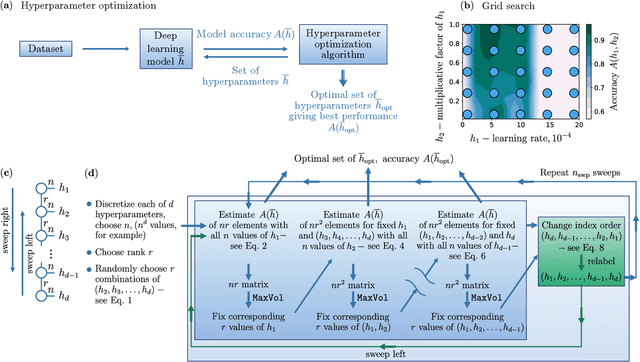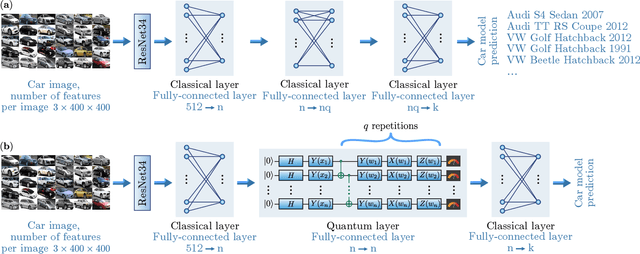Andrii Kurkin
A supervised hybrid quantum machine learning solution to the emergency escape routing problem
Jul 28, 2023Abstract:Managing the response to natural disasters effectively can considerably mitigate their devastating impact. This work explores the potential of using supervised hybrid quantum machine learning to optimize emergency evacuation plans for cars during natural disasters. The study focuses on earthquake emergencies and models the problem as a dynamic computational graph where an earthquake damages an area of a city. The residents seek to evacuate the city by reaching the exit points where traffic congestion occurs. The situation is modeled as a shortest-path problem on an uncertain and dynamically evolving map. We propose a novel hybrid supervised learning approach and test it on hypothetical situations on a concrete city graph. This approach uses a novel quantum feature-wise linear modulation (FiLM) neural network parallel to a classical FiLM network to imitate Dijkstra's node-wise shortest path algorithm on a deterministic dynamic graph. Adding the quantum neural network in parallel increases the overall model's expressivity by splitting the dataset's harmonic and non-harmonic features between the quantum and classical components. The hybrid supervised learning agent is trained on a dataset of Dijkstra's shortest paths and can successfully learn the navigation task. The hybrid quantum network improves over the purely classical supervised learning approach by 7% in accuracy. We show that the quantum part has a significant contribution of 45.(3)% to the prediction and that the network could be executed on an ion-based quantum computer. The results demonstrate the potential of supervised hybrid quantum machine learning in improving emergency evacuation planning during natural disasters.
Forecasting the steam mass flow in a powerplant using the parallel hybrid network
Jul 18, 2023Abstract:Efficient and sustainable power generation is a crucial concern in the energy sector. In particular, thermal power plants grapple with accurately predicting steam mass flow, which is crucial for operational efficiency and cost reduction. In this study, we use a parallel hybrid neural network architecture that combines a parametrized quantum circuit and a conventional feed-forward neural network specifically designed for time-series prediction in industrial settings to enhance predictions of steam mass flow 15 minutes into the future. Our results show that the parallel hybrid model outperforms standalone classical and quantum models, achieving more than 5.7 and 4.9 times lower mean squared error (MSE) loss on the test set after training compared to pure classical and pure quantum networks, respectively. Furthermore, the hybrid model demonstrates smaller relative errors between the ground truth and the model predictions on the test set, up to 2 times better than the pure classical model. These findings contribute to the broader scientific understanding of how integrating quantum and classical machine learning techniques can be applied to real-world challenges faced by the energy sector, ultimately leading to optimized power plant operations.
Benchmarking simulated and physical quantum processing units using quantum and hybrid algorithms
Nov 28, 2022Abstract:Powerful hardware services and software libraries are vital tools for quickly and affordably designing, testing, and executing quantum algorithms. A robust large-scale study of how the performance of these platforms scales with the number of qubits is key to providing quantum solutions to challenging industry problems. Such an evaluation is difficult owing to the availability and price of physical quantum processing units. This work benchmarks the runtime and accuracy for a representative sample of specialized high-performance simulated and physical quantum processing units. Results show the QMware cloud computing service can reduce the runtime for executing a quantum circuit by up to 78% compared to the next fastest option for algorithms with fewer than 27 qubits. The AWS SV1 simulator offers a runtime advantage for larger circuits, up to the maximum 34 qubits available with SV1. Beyond this limit, QMware provides the ability to execute circuits as large as 40 qubits. Physical quantum devices, such as Rigetti's Aspen-M2, can provide an exponential runtime advantage for circuits with more than 30. However, the high financial cost of physical quantum processing units presents a serious barrier to practical use. Moreover, of the four quantum devices tested, only IonQ's Harmony achieves high fidelity with more than four qubits. This study paves the way to understanding the optimal combination of available software and hardware for executing practical quantum algorithms.
Hyperparameter optimization of hybrid quantum neural networks for car classification
May 10, 2022



Abstract:Image recognition is one of the primary applications of machine learning algorithms. Nevertheless, machine learning models used in modern image recognition systems consist of millions of parameters that usually require significant computational time to be adjusted. Moreover, adjustment of model hyperparameters leads to additional overhead. Because of this, new developments in machine learning models and hyperparameter optimization techniques are required. This paper presents a quantum-inspired hyperparameter optimization technique and a hybrid quantum-classical machine learning model for supervised learning. We benchmark our hyperparameter optimization method over standard black-box objective functions and observe performance improvements in the form of reduced expected run times and fitness in response to the growth in the size of the search space. We test our approaches in a car image classification task, and demonstrate a full-scale implementation of the hybrid quantum neural network model with the tensor train hyperparameter optimization. Our tests show a qualitative and quantitative advantage over the corresponding standard classical tabular grid search approach used with a deep neural network ResNet34. A classification accuracy of 0.97 was obtained by the hybrid model after 18 iterations, whereas the classical model achieved an accuracy of 0.92 after 75 iterations.
 Add to Chrome
Add to Chrome Add to Firefox
Add to Firefox Add to Edge
Add to Edge